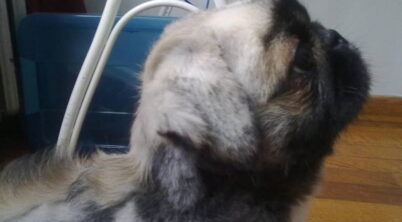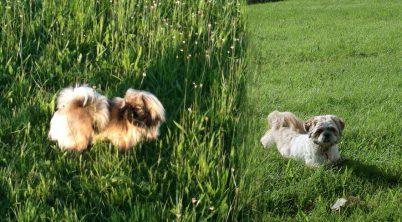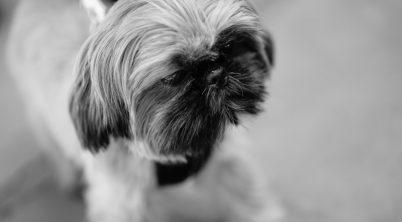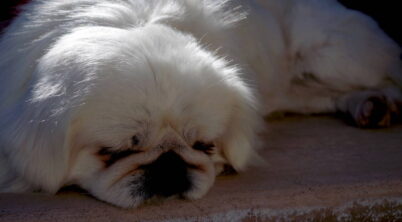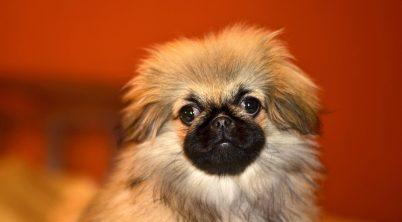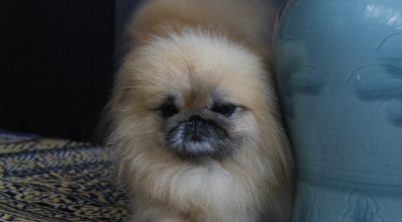The Pekingese, a compact toy companion with regal bearing and a distinctive rolling gait, has long been a favorite among dog enthusiasts. Originating from ancient China, this breed has a sophisticated lineage and unique traits that make them stand out from other toy breeds. Known for their loving, gentle, and playful nature, Pekingese dogs can be an ideal choice for households looking for a family pet.
While the Pekingese may be small, it is also quite feisty. This interesting combination makes them great companions for families with or without children. Their social and adaptable nature allows them to comfortably fit into various family settings, providing an affectionate and loyal presence to those who share their home with these charming dogs. However, it is important to remember that the success of a Pekingese as a family pet also requires proper care, training, and understanding of their temperament.
Historical Background
The Pekingese, a toy dog breed, originated in ancient China where it was considered sacred and closely associated with the Chinese imperial family. Owned by aristocrats and royalty, the breed was highly revered and pampered in the palaces, living in luxurious surroundings with soft silk cushions.
In 1860, during the Second Opium War, British forces looted the Imperial Palace in Peking (now Beijing) and discovered the Pekingese dogs. These dogs were then brought to England, where they gained popularity rapidly. Queen Victoria herself owned a Pekingese, further solidifying the breed’s status.
In the United States, the Pekingese Club of America was formed in the early 20th century, giving the breed a dedicated space to thrive and flourish as a popular companion dog. Over the years, the Pekingese has maintained its regal and poised stature, making it a favorite breed among families looking for a loving and loyal pet.
Physical Attributes
The Pekingese is a small, compact dog with a variety of coat colors and distinctive physical features. Their coat can come in different shades, such as tan, red, black, white, cream, gray, and sable. They have a double coat, which consists of a coarse outer layer and a soft, dense undercoat.
One of the breed’s striking features is their large eyes that are dark and expressive. Their ears are floppy and lie close to their head. With a height ranging between 6 to 9 inches and a weight of up to 14 pounds, Pekingese dogs are part of the toy breed group.
These dogs have a unique physical attribute – their tail. It is usually curled over their back and decorated with feathery hair, adding to their royal appearance. With their distinctive looks, Pekingese dogs make quite an impression as a family pet.
Temperament and Personality
Known Traits
The Pekingese is a confident, independent, and loyal dog breed. They are alert, intelligent, and gentle, which makes them good companions. Known for their strong-willed and sometimes stubborn nature, these dogs are also affectionate and loving. Pekes can be playful, yet they have a dignified presence that reflects their royal ancestry. They also serve as watchdogs due to their innate tendency to be vocal.
Early Socialization Importance
It’s crucial to begin socializing the Pekingese early to help them overcome any stubbornness and develop a well-rounded personality. Proper socialization exposes them to different people, environments, and animals, helping them adapt better in various situations. This process enhances their confidence and allows them to express their natural traits positively, making them suitable family pets.
Pekingese as Family Pets
Interactions with Older Children
The Pekingese is a loyal and gentle pet, making it a good choice for families with older children. These small dogs are affectionate and enjoy spending time with their human companions. Although they are a toy breed, they thrive in environments where they receive consistent love and attention. It is important for older children to handle these dogs gently to avoid injuries.
Compatibility with Other Pets
Pekingese can get along with other pets when socialized and introduced properly. Although they can be a bit possessive of their owners, proper training and early socialization can help them coexist harmoniously with other pets in the household.
Living in Apartments
Pekingese are well-suited for apartment living due to their small size and low exercise requirements. Their compact build allows them to navigate apartment spaces easily. They can be sensitive to temperature changes, making indoor living preferable. Keep in mind that they may be prone to barking. Consistent training can help manage this trait.
Training and Behavior
Addressing Stubbornness
Pekingese dogs can be stubborn and sometimes challenging to train. Consistency and patience are key when working with this breed. It is crucial to establish yourself as the leader and use positive reinforcement methods, such as treats and praise, to encourage good behavior.
Pekingese Training Tips
- Begin training your Pekingese early, ideally as a puppy.
- Use short and consistent training sessions, as Pekingese tend to have a shorter attention span.
- Be patient and persistent; never use harsh or negative training methods.
- Focus on socialization by exposing the Pekingese to a variety of environments, people, and other animals.
Maintaining Good Behavior
To maintain good behavior in your Pekingese, regularly reinforce their training with consistent rules and expectations. Provide mental and physical stimulation through activities such as playtime and puzzle toys. Be mindful of the breed’s potential health problems and consult a veterinarian for any concerns. By following these guidelines, you can foster a well-behaved Pekingese as a loving and cherished family member.
Grooming and Maintenance
Pekingese dogs have a unique coat that requires consistent grooming. Daily brushing is essential to prevent matting and tangles. It’s best to use a slicker brush, starting from the head and working your way down to the undercoat, which can easily mat due to its density.
In addition to brushing, Pekingese should be bathed every 3-4 weeks to keep their coat clean and healthy. Shedding is not excessive, but regular grooming helps to manage it. Exercise is also an important aspect of Pekingese maintenance. Although they don’t require intense daily exercise, two 20-minute walks per day will help keep them fit and happy. Indoor activities such as playing fetch or hide and seek can be great alternatives on hot or rainy days.
In summary, maintaining a Pekingese’s coat with regular brushing, bathing, and exercise contributes to their overall well-being and happiness as a family pet.
Health and Well-being
The Pekingese is a brachycephalic breed, which makes them prone to certain health concerns. Due to their shortened facial structure, they may experience breathing difficulties, especially in hot weather or during vigorous exercise. It is vital to monitor them in such conditions to avoid overheating.
One of the main health problems in Pekingese dogs is Patellar Luxation, where the kneecap slips out of its proper groove causing discomfort. This condition might lead to arthritis and can affect the dog’s mobility.
Obesity is another concern for Pekingese, as they have a relatively low exercise requirement. Proper diet and regular low-impact exercises are essential to maintain their weight and overall well-being. It’s important to balance their food intake and activity level to keep them healthy and prevent excessive weight gain.
Choosing a Pekingese
Considerations Before Adoption
The Pekingese dog breed is known for its loyalty, affection, and playful nature, making it a potentially good choice for a family pet. However, it’s important to be aware that these dogs can be stubborn and may require more attention and training than other breeds. As watchdogs, Pekingese dogs are extremely protective of their family and territory.
Pekingese Breed Popularity
When selecting a family dog, considering the breed’s popularity can provide insight into its overall characteristics and suitability for your household. Pekingese are known to be highly popular among potential dog owners due to their loyalty, personality, and unique appearance. While popularity can be indicative of a breed’s positive traits, it is crucial for prospective owners to research and understand the specific needs and requirements of Pekingese to ensure an ideal fit for their household.

